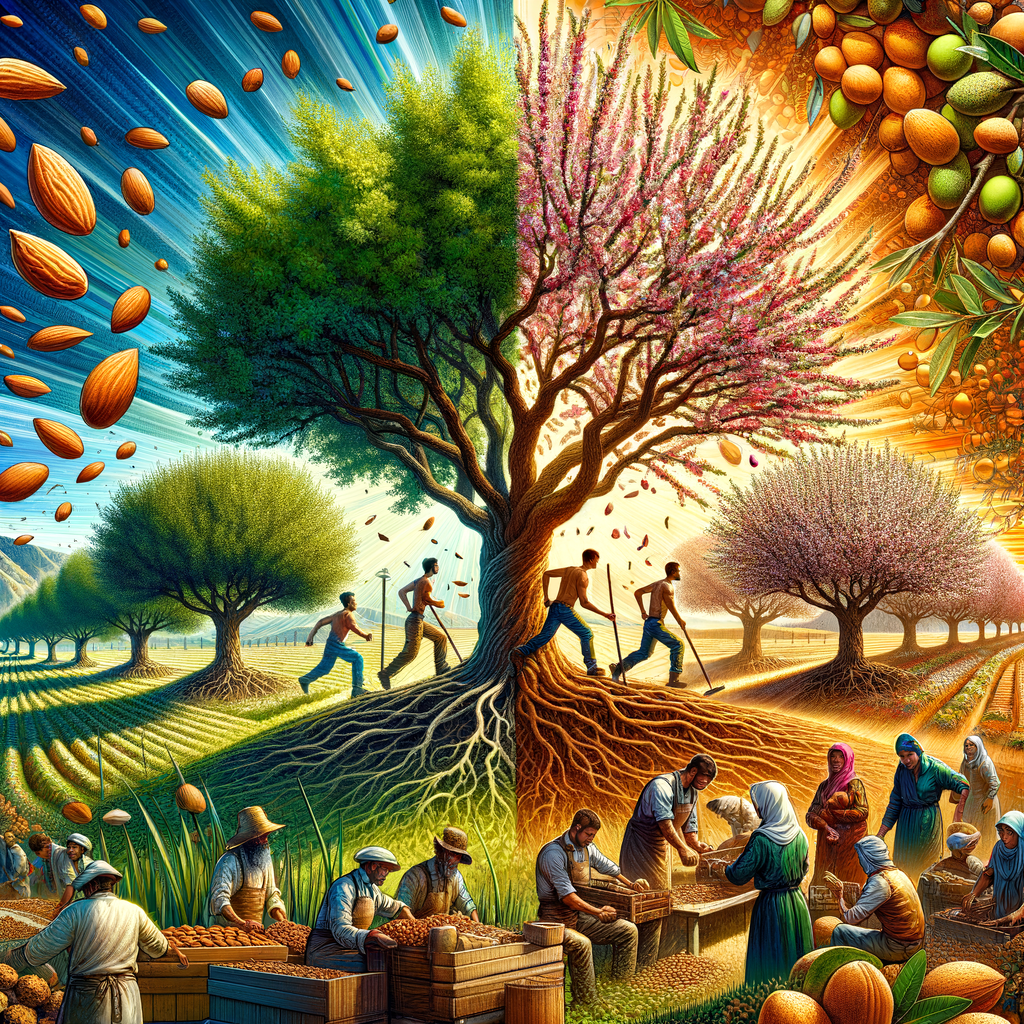
Introduction to Almond Tree Cultivation
Welcome to the fascinating world of almond tree cultivation! Almond trees are not only beautiful, but they also produce delicious and nutritious nuts that are enjoyed by people all over the world. Let’s delve into the details of almond tree agriculture, understand its importance, and explore the regions known for almond farming.
-
- Overview of Almond Tree Agriculture
Almond tree agriculture is an important sector in the farming industry. These trees are grown for their delicious nuts, which are used in a variety of foods, from snacks and desserts to health foods. The almond tree is a deciduous tree that grows well in warm climates with dry summers and mild winters. It requires well-drained soil and plenty of sunlight. The trees start to produce nuts in their third year, but it takes about five years for them to fully mature and produce a full crop.
-
- Importance of Almond Tree Plantation
Almond tree plantations play a significant role in the economy of many regions. Almonds are a valuable commodity, and their cultivation provides jobs and income for many people. Moreover, almond trees are beneficial for the environment. They help to improve air quality, reduce soil erosion, and provide habitat for wildlife. Additionally, almonds are a great source of nutrition. They are packed with protein, fiber, and healthy fats, making them a healthy snack choice.
-
- Regions Known for Almond Farming
Almond farming is a global practice, with certain regions being particularly known for it. The United States, specifically California, is the largest producer of almonds in the world. Spain, Italy, and Australia are also significant almond producers. These regions have the ideal climate and soil conditions for almond cultivation. In these areas, you can see vast landscapes of almond orchards, especially during the blooming season when the trees are covered with beautiful pink and white flowers.
Impact of Almond Trees on Microclimate
Almond trees, like other plants, play a significant role in shaping the microclimate of their surroundings. To understand this better, let’s first get a grasp of what a microclimate is and what factors influence it.
Understanding Microclimate
A microclimate is a local atmospheric zone where the climate differs from the surrounding area. The term may refer to areas as small as a few square feet or as large as many square miles. Now, let’s break it down further.
-
- Definition of microclimate
A microclimate is a small area that has different weather or climate than the area around it. This could be a tiny spot in your backyard or a city park. These unique climates can be warmer, cooler, wetter, or drier than the surrounding area.
-
- Factors influencing microclimate
Several factors can influence a microclimate. These include the type of surface (like concrete, water, or grass), the amount of sunlight it gets, and the presence of buildings or trees. For example, a city park with lots of trees might be cooler than a nearby parking lot because the trees provide shade and release water into the air.
Now that we have a better understanding of microclimates, we can delve into the role of almond trees in shaping these unique environmental pockets. Stay tuned for the next section where we will explore how almond trees affect temperature, humidity, and wind speed in their immediate surroundings.
Microclimate Changes Due to Almond Trees
Almond trees, like other plants, have a significant impact on the microclimate of their surroundings. They influence temperature, humidity, and wind speed. Let’s delve into these effects in more detail.
-
- How Almond Trees Affect Temperature
Almond trees have a unique way of modifying the temperature around them. During the day, their broad leaves provide shade, which cools the ground below. This can lower the surrounding temperature by several degrees. At night, these trees release heat absorbed during the day, creating a warming effect. This temperature regulation is essential for the growth and development of the almond tree itself and other plants and animals in the vicinity.
-
- Almond Trees and Humidity Changes
Humidity is another aspect of the microclimate that almond trees influence. They release water vapor into the air through a process called transpiration. This increases the humidity level in the immediate surroundings. Higher humidity can be beneficial for many plants and animals, creating a more hospitable environment.
-
- Effects of Almond Trees on Wind Speed
Almond trees can also affect wind speed. Their height and the density of their branches and leaves act as a natural windbreak, reducing wind speed in the immediate area. This can protect more delicate plants from wind damage and prevent soil erosion.
In conclusion, almond trees play a crucial role in shaping the microclimate of their surroundings. They help regulate temperature, increase humidity, and reduce wind speed, creating a more balanced and hospitable environment for other organisms.
| Microclimate Factor | Effect of Almond Trees |
|---|---|
| Temperature | Regulates temperature by providing shade and releasing heat |
| Humidity | Increases humidity through transpiration |
| Wind Speed | Reduces wind speed by acting as a natural windbreak |
Almond Farming and Environment
Almond farming plays a significant role in our environment. It’s not just about producing tasty nuts; almond trees offer a host of environmental benefits too. Let’s explore these benefits in detail.
Environmental Benefits of Almond Trees
Almond trees contribute positively to the environment in several ways. They help in carbon sequestration, improve soil health, and promote biodiversity. Here’s how:
-
- Carbon sequestration by almond trees
Almond trees are excellent at absorbing and storing carbon dioxide from the atmosphere, a process known as carbon sequestration. This process helps in reducing greenhouse gases and combating climate change. A study reveals that one acre of almond trees can absorb about 2 tons of CO2 annually. That’s equivalent to the emissions from driving a car for 4,500 miles!
-
- Almond trees and soil health
Almond trees also contribute to soil health. The leaves and shells of almonds, when decomposed, enrich the soil with essential nutrients. This organic matter improves soil structure, enhances its water-holding capacity, and promotes the growth of beneficial microorganisms. Healthy soil is not just good for almond trees but also for the crops that follow in rotation.
-
- Almond trees and biodiversity
Almond orchards are a haven for biodiversity. They provide habitat for various species of birds, insects, and other wildlife. During the almond bloom, the orchards are buzzing with bees that come for nectar and pollen. These bees play a crucial role in pollinating the almond flowers, leading to a successful harvest. Thus, almond trees help in maintaining a balanced ecosystem.
In conclusion, almond farming is not just about producing almonds. It’s about creating a sustainable environment for future generations. So, the next time you enjoy those crunchy almonds, remember the environmental benefits they bring along!
Environmental Challenges in Almond Farming
While almond farming has numerous environmental benefits, it also poses certain challenges. Two of the most significant issues are water usage and pest management. Let’s delve into these topics.
- Water usage in almond farming
Almond trees require a lot of water. In fact, it takes about one gallon of water to grow a single almond. This high water demand can be a challenge, especially in areas where water is scarce.
According to a study, an almond orchard can consume up to 4 acre-feet of water per acre each year. This is equivalent to filling four football fields with a foot of water! This high water usage can lead to water scarcity in the surrounding areas, impacting other crops and the local ecosystem.
- Pest management in almond orchards
Another challenge in almond farming is managing pests. Almond trees are susceptible to various pests, including the Navel Orangeworm, Peach Twig Borer, and Almond Moth. These pests can cause significant damage to the almond crops, reducing yield and quality.
Pest management in almond orchards often involves the use of pesticides. However, these chemicals can have negative effects on the environment, including polluting water sources and harming non-target organisms like bees and other beneficial insects.
Despite these challenges, farmers and researchers are continuously working on sustainable solutions. For instance, some are exploring the use of less water-intensive farming methods and organic pest control strategies. This way, we can continue to enjoy the benefits of almond trees while minimizing their environmental impact.
Almond Orchards and Climate
Almond trees, like all other plants, have specific climate requirements that need to be met for them to thrive. Understanding these requirements is crucial for successful almond cultivation.
Climate Requirements for Almond Trees
Almond trees have two primary climate requirements: temperature and water. Let’s delve into these requirements in more detail.
-
- Temperature requirements for almond trees
Almond trees thrive in a Mediterranean climate, which is characterized by mild, wet winters and hot, dry summers. They require a certain period of cold weather, typically between 32°F and 45°F, to break dormancy and start new growth. This period, known as chilling requirement, varies among almond varieties but is typically between 200 and 400 hours. During the growing season, almond trees prefer temperatures between 59°F and 86°F. Temperatures above 95°F can cause stress to the trees and reduce their productivity.
-
- Water requirements for almond trees
Almond trees need a consistent supply of water, especially during the growing season. On average, an almond tree requires about 40 inches of water per year, including rainfall. However, the exact amount can vary depending on the tree’s age, size, and health, as well as the soil type and climate conditions. Overwatering can lead to root rot and other diseases, while underwatering can cause the tree to become stressed and less productive.
In conclusion, understanding the climate requirements of almond trees is crucial for successful almond cultivation. By providing the right temperature and water conditions, you can help your almond trees thrive and produce a bountiful harvest.
Climate Change and Almond Farming
Climate change is a global issue that affects various sectors, including agriculture. Almond farming, in particular, is significantly impacted by changes in the climate. Let’s delve into how climate change affects almond farming and how farmers are adapting to these changes.
-
- Impact of Climate Change on Almond Farming
Climate change has a profound impact on almond farming. Almond trees require specific conditions to grow and produce nuts. They need a particular range of temperature and a certain amount of water. With the changing climate, these conditions are becoming harder to maintain.
For instance, almond trees need cold winters for the nuts to form properly. However, with global warming, winters are becoming warmer, which affects the growth of the almonds. Additionally, droughts, which are becoming more frequent due to climate change, can lead to water scarcity. This is a major problem as almond trees need a lot of water to produce nuts.
According to a study, the yield of almond trees has decreased by 10% due to climate change. This is a significant decrease considering the high demand for almonds worldwide.
-
- Adapting Almond Farming to Climate Change
Despite the challenges posed by climate change, almond farmers are finding ways to adapt. They are using innovative farming techniques and technologies to cope with the changing climate.
For example, some farmers are using drip irrigation systems to conserve water. This system allows water to drip slowly to the roots of the plants, reducing water wastage. Others are using shade nets to protect the trees from extreme heat.
Moreover, farmers are also experimenting with different varieties of almond trees that are more resistant to heat and drought. This is a promising strategy as it could help ensure the sustainability of almond farming in the face of climate change.
In conclusion, climate change poses significant challenges to almond farming. However, with innovative farming techniques and the development of more resilient almond varieties, farmers are finding ways to adapt and ensure the sustainability of this important crop.
Influence of Trees on Microclimate
Trees play a significant role in shaping the microclimate of an area. They influence temperature and precipitation patterns, creating a unique environment that supports a diverse range of flora and fauna. Let’s delve into the details.
General Impact of Trees on Microclimate
Trees have a profound impact on the microclimate, which can be seen in two main aspects:
-
- How trees modify temperature
Trees are nature’s air conditioners. They absorb sunlight and release moisture into the air through a process called transpiration. This cools the surrounding air. In fact, a single mature tree can reduce summer temperatures by as much as 9 degrees Fahrenheit! This cooling effect is not just limited to the day. At night, trees release stored heat, helping to maintain a stable temperature.
-
- Role of trees in precipitation patterns
Trees also play a crucial role in precipitation patterns. Through transpiration, trees release water vapor into the air. This water vapor forms clouds that eventually lead to rainfall. In areas with dense tree cover, this can result in increased rainfall. Studies have shown that deforestation can lead to a decrease in local rainfall, highlighting the importance of trees in maintaining precipitation patterns.
In conclusion, trees have a significant influence on the microclimate, affecting both temperature and precipitation patterns. They help to create a stable, hospitable environment that supports a wide variety of life. As such, maintaining and increasing tree cover is crucial for preserving our planet’s diverse ecosystems.
Specific Impact of Almond Trees on Microclimate
Almond trees, like other trees, have a significant influence on the microclimate of their surroundings. However, the specific impact of almond trees is unique and worth exploring. Let’s delve into a case study and key takeaways to understand this better.
-
- Case study: Almond tree plantation and microclimates
In a study conducted in California, the world’s largest producer of almonds, it was observed that almond tree plantations have a cooling effect on the local climate. During the day, almond trees absorb sunlight and use it for photosynthesis, a process that also involves the absorption of carbon dioxide and release of oxygen. At night, these trees release heat absorbed during the day, warming the surrounding air. This cycle creates a cooler microclimate during the day and a warmer one at night, compared to areas without almond trees.
-
- Key takeaways: Effects of almond trees on local climate
| Impact | Description |
|---|---|
| Temperature Regulation | Almond trees create a cooler microclimate during the day and a warmer one at night, providing a balanced temperature. |
| Humidity Control | Through transpiration, almond trees release water vapor into the air, increasing local humidity and influencing rainfall patterns. |
| Carbon Sequestration | Almond trees absorb carbon dioxide for photosynthesis, reducing the amount of this greenhouse gas in the atmosphere. |
These key takeaways highlight the significant role almond trees play in shaping the microclimate of their surroundings. Not only do they regulate temperature and humidity, but they also contribute to carbon sequestration, making them an essential part of the ecosystem.
Almond Trees and Ecological Impact
Almond trees play a significant role in our ecosystem. They not only produce delicious nuts but also contribute positively to the environment. Let’s explore the positive ecological impacts of almond trees.
Positive Ecological Impact of Almond Trees
Almond trees have a positive impact on the environment in two main ways: they provide habitats for wildlife and help control soil erosion.
-
- Almond trees and wildlife habitats
Almond trees provide a home for a variety of wildlife. Birds, insects, and small mammals all find shelter in the branches and leaves of almond trees. In fact, a single almond tree can host hundreds of different species, contributing to biodiversity in the area. For instance, bees often use almond trees for pollination, which is a crucial process in the life cycle of plants.
-
- Almond trees and soil erosion control
Almond trees also play a vital role in controlling soil erosion. Their extensive root systems hold the soil together, preventing it from being washed away by rain or wind. This is particularly important in hilly or sloping areas where soil erosion can be a major problem. By anchoring the soil, almond trees help maintain the health of the land and prevent degradation.
In conclusion, almond trees are not just producers of tasty nuts. They also play a vital role in maintaining ecological balance by providing habitats for wildlife and controlling soil erosion. So, the next time you enjoy a handful of almonds, remember the positive impact these trees are having on our environment.
Negative Ecological Impact of Almond Trees
While almond trees have many benefits, they also have some negative impacts on the environment. Let’s explore these issues and discuss how we can address them.
- Issues with Monoculture Almond Orchards
Monoculture refers to the agricultural practice of growing a single crop year after year on the same land. This is common in almond orchards, but it can lead to problems. For example, it can deplete the soil of certain nutrients, leading to poorer soil health over time.
According to a study by the University of California, Davis, monoculture almond orchards can also lead to a loss of biodiversity. This is because they don’t provide a diverse habitat for different species of wildlife. They also require a lot of water, which can be a problem in areas where water is scarce.
- Addressing the Ecological Challenges of Almond Farming
Despite these challenges, there are ways to make almond farming more sustainable. One approach is to use more diverse farming methods. This could include rotating crops, which can help improve soil health and biodiversity.
Another approach is to use more efficient irrigation methods. For example, drip irrigation can help save water by delivering it directly to the roots of the plants. This can help reduce the amount of water needed for almond farming.
Lastly, farmers can also plant cover crops. These are plants that are grown to cover the soil rather than for the purpose of being harvested. Cover crops can help improve soil health, reduce erosion, and provide habitat for beneficial insects.
In conclusion, while there are challenges associated with almond farming, there are also solutions. By adopting more sustainable farming practices, we can help reduce the negative ecological impact of almond trees.
Conclusion: The Incredible Almond Tree
The almond tree, with its rich history and ecological impact, is truly an incredible specimen. As we’ve explored in this article, it plays a significant role in shaping microclimates and holds promising prospects for future cultivation. Let’s summarize these points.
-
- Summary of the almond tree’s impact on microclimates
The almond tree has a profound impact on microclimates. Its broad leaves provide shade, reducing ground temperature and evaporation rates. This leads to a cooler, more humid environment beneath the tree canopy. Furthermore, the tree’s deep root system allows it to access water from deep within the soil, helping to maintain soil moisture levels. This not only benefits the almond tree itself but also the surrounding vegetation and wildlife.
-
- Future prospects for almond tree cultivation
Looking ahead, the almond tree holds promising prospects. With increasing awareness of its environmental benefits, more farmers are considering almond tree cultivation. Advances in technology and farming practices are also making it easier to grow these trees in a variety of climates. However, it’s important to remember that successful cultivation requires careful planning and management. With the right approach, the almond tree can continue to be a valuable resource for both people and the planet.
In conclusion, the almond tree is more than just a source of delicious nuts. It’s a vital part of our ecosystem, playing a key role in shaping microclimates and offering potential for sustainable farming. As we move forward, let’s continue to appreciate and protect these incredible trees.







